Section 1: Agency overview and resources
1.1 Strategic direction
The Office of the Australian Accounting Standards Board (AASB) is an Australian Government agency under the Australian Securities and Investments Commission Act 2001.
The functions of the AASB are to:
- develop a conceptual framework for the purpose of evaluating proposed accounting standards and international standards;
- make accounting standards under section 334 of the Corporations Act 2001 for the purposes of the corporations legislation;
- formulate accounting standards for other purposes;
- participate in and contribute to the development of a single set of accounting standards for world-wide use; and
- facilitate the Australian economy by reducing the cost of capital, enabling Australian entities to compete effectively overseas, leaving accounting standards that are clearly stated and easily to understand, and to maintain investor confidence in the Australian economy (including its capital markets).
The vision of the AASB is to build on its reputation as a leading national standard setter and be recognised as a global centre of excellence, delivering a truly distinctive contribution to the development of high quality financial reporting standards.
The mission of the AASB is to develop and maintain high quality financial reporting standards for all sectors of the Australian economy and contribute, through leadership and talent, to the development of global financial reporting standards and be recognised as facilitating the inclusion of the Australian community in the activity of global standard setting.
Key priorities during 2011-12 include:
- issue Australian consultative documents incorporating International Accounting Standards Board (IASB) exposure drafts and discussion papers to encourage Australian constituents to be involved in the process and provide the AASB with information for making its own comments to the IASB;
- ensure that changes to International Financial Reporting Standards (IFRS) are processed expeditiously and are communicated to Australian constituents;
- work closely with the New Zealand Financial Reporting Standards Board to converge reporting requirements across the Tasman, consistent with the Outcome Proposals agreed in August 2009 by the Australian and New Zealand Prime Ministers;
- implement the new differential reporting framework, (Reduced Disclosure Regime);
- actively pursue an agenda relevant to public sector and the not-for–profit private sector, whilst maintaining a transaction neutral approach;
- participate in ongoing projects of the International Public Sector Accounting Standards Board (IPSASB) with a view to promoting and improving the IPSASB's output;
- issue a revised Standard on financial reporting by superannuation plans; and
- work closely both in the Asia Oceania and global arenas to promote Australian thought leadership and influence.
1.2 Agency resource statement
Table 1.1 shows the total resources from all sources. The table summarises how resources will be applied by outcome and by departmental classification.
Table 1.1: Australian Accounting Standards Board resource statement — Budget
estimates for 2011-12 as at Budget May 2011
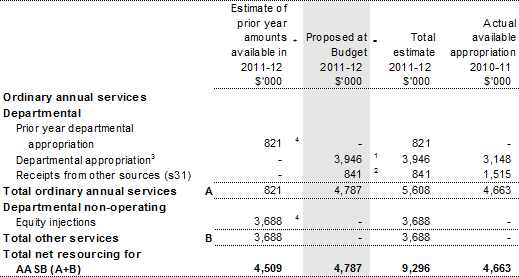
1 Appropriation Bill (No. 1) 2011-12.
2. Receipts under s31 of the Financial Management and Accountability Act 1997.
3. Includes $0.1 million in 2011-12 for the departmental capital budget (refer to Table 3.2.5 for further details).
4. Estimated adjusted balance carried from previous year for annual appropriations.
1.3 Budget measures
Budget measures relating to AASB are detailed in Budget Paper No. 2, Budget Measures 2011-12 and are summarised below.
Table 1.2: Australian Accounting Standards Board 2011-12 Budget measures
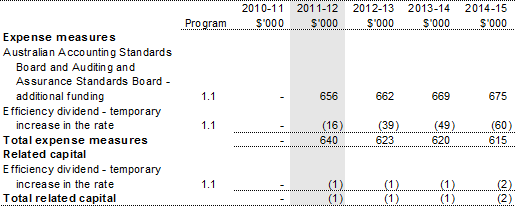
Section 2: Outcomes and planned performance
2.1 Outcomes and performance information
Government outcomes are the intended results, impacts or consequences of actions by the Government on the Australian community. Commonwealth programs are the primary vehicle by which government agencies achieve the intended results of their outcome statements. Agencies are required to identify the programs which contribute to Government outcomes over the Budget and forward years.
The AASB's outcome is described below specifying the strategy, program, objective, deliverables and key performance indicators used to assess and monitor the performance of the AASB.
Outcome 1: The formulation and making of accounting standards that are used by Australian entities to prepare financial reports and enable users of these reports to make informed decisions
Outcome 1 strategy
The key strategies to achieve Outcome 1 are:
- to make accounting standards under section 334 of the Corporations Act 2001 for the purposes of the financial reporting requirements of the Corporations legislation and providing guidance on the interpretation of those standards;
- formulating accounting standards for purposes of financial reporting by Australian entities that are not subject to the reporting requirements of the Corporations legislation and providing guidance on the interpretation of those standards; and
- to provide Australian participation in, and contribution to, the development of a single set of accounting standards for world-wide use.
The AASB will continue its role in the development of legally enforceable accounting standards, the development of accounting standards for non Corporation's legislation entities and the development of global accounting standards.
Outcome expense statement
Table 2.1 provides an overview of the total expenses for Outcome 1.
Table 2.1: Budgeted expenses for Outcome 1
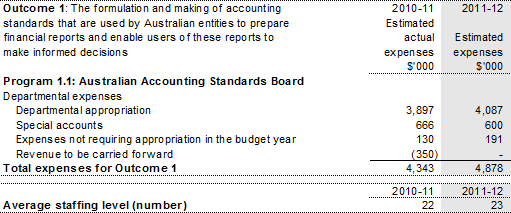
Contributions to Outcome 1
Program 1: Australian Accounting Standards Board
Program objective
The objectives of the AASB are:
- ensure Australian for-profit entities complying with Australian Accounting Standards would also be complying with the IFRS;
- to the extent feasible ensure transactions are accounted for in the same way by all entities — that is, to the extent feasible, ensure Australian Accounting Standards are transaction neutral, which requires consideration by the AASB of how each IFRS might affect not-for-profit entities in the public and private sectors;
- maintain and enhance Australia's reputation as a leading national accounting standard setter in the interests of making an important contribution to setting high-quality global standards. This also involves establishing and maintaining working relationships with other national standard setters (particularly in the region), the IASB and the IPSASB;
- drive improvements in financial reporting, particularly on issues not being dealt with internationally, including those relating to not-for-profit entities in the public and private sectors when a purely transaction neutral approach does not prove feasible;
- have consistent interpretations of requirements and encourage other jurisdictions to do the same through relationships with other standard setters;
- have an up-to-date and easy-to-use website and report on AASB dec
isions and projects on a timely basis; and - develop staff with expertise in standard setting through graduate and secondment programs.
Program expenses
There are no significant changes to estimates across the forward years.
Table 2.2: Program expenses

Program deliverables
The AASB has the following deliverables:
- promulgate each IFRS and IFRS amendment developed by the IASB into Australian Law;
- promulgate each standard to apply on a transaction neutral basis to the extent feasible and develop specific standards to deal with not-for-profit entity issues where necessary;
- prepare and publish accounting standards, compiled versions of standards and exposure drafts;
- participate in international standards setting and other research projects;
- maintain close relationships with equivalent organisations in other jurisdictions; and
- develop personnel with experience in standard setting.
Program key performance indicators
The AASB has the following key performance indicators:
- accounting standard and standard amendments to be developed by the IASB are in accordance with Australian legislative drafting protocols and Federal Register of Legislative Instruments requirements;
- regular consultation and liaison with a broad range of Australian constituents;
- accounting standards or compilations are lodged on the Federal Register of Legislative Instruments and are published on the AASB website within three days of finalisation;
- responses are made to all significant IASB and IPSASB exposure drafts;
- host and/or attendance at National Standards-Setters Group and Asian-Oceanian Standard-Setters Group meetings and participate in the work of the Trans-Tasman Accounting and Auditing Standards Advisory Group; and
- developmental opportunities for accounting professionals, including recent graduates and secondments, are provided.
Section 3: Explanatory tables and budgeted financial statements
Section 3 presents explanatory tables and budgeted financial statements which provide a comprehensive snapshot of the agency finances for the 2011-12 budget year. It explains how budget plans are incorporated into the financial statements and provides further details of the reconciliation between appropriations and program expenses, movements in administered funds, special accounts and government Indigenous expenditure.
3.1 Explanatory tables
3.1.1 Movement of administered funds between years
The AASB does not have any administered funds.
3.1.2 Special accounts
Special accounts provide a means to set aside and record amounts used for specified purposes. Special accounts can be created by a Finance Minister's Determination under the Financial Management and Accountability Act 1997 or under separate enabling legislation. Table 3.1.2 shows the expected additions (receipts) and reductions (payments) for each account used by the AASB.
Table 3.1.2: Estimates of special account cash flows and balances
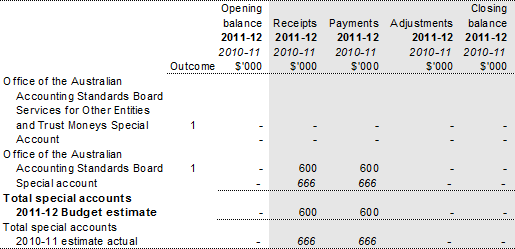
3.1.3 Australian Government Indigenous Expenditure
The AASB does not have any Australian Government Indigenous Expenditure.
3.2 Budgeted financial statements
3.2.1 Differences in agency resourcing and financial statements
There are no differences between agency resourcing and financial statements.
3.2.2 Analysis of budgeted financial statements
The AASB is budgeting for a break-even operating result for 2011-12 after adding back non-appropriated depreciation and amortisation expenses.
3.2.3 Budgeted financial statements tables
Table 3.2.1: Budgeted departmental comprehensive income statement
(for the period ended 30 June)
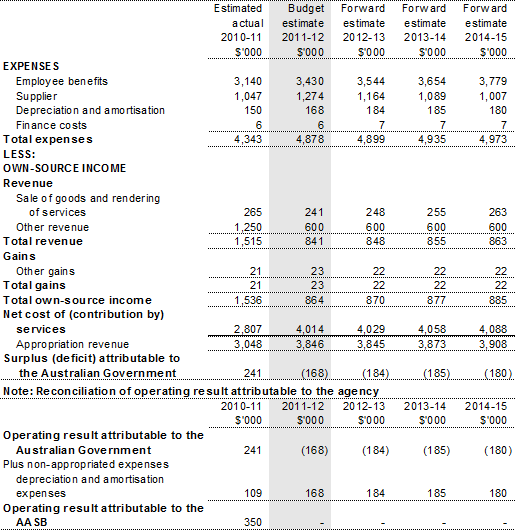
Prepared on Australian Accounting Standards basis.
Table 3.2.2: Budgeted departmental balance sheet
(as at 30 June)
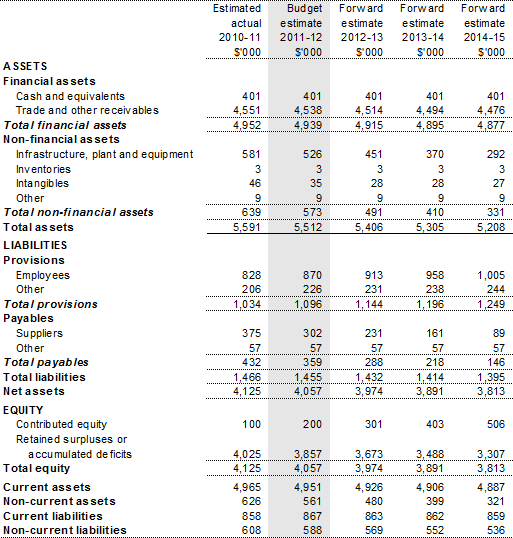
Prepared on Australian Accounting Standards basis.
Table 3.2.3: Budgeted departmental statement of cash flows
(for the period ended 30 June)
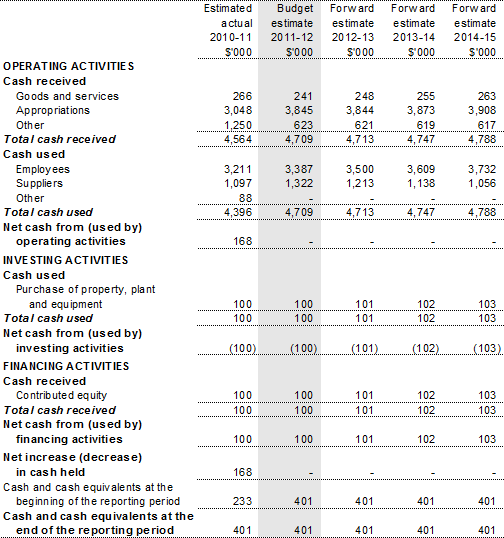
Prepared on Australian Accounting Standards basis.
Table 3.2.4: Departmental statement of changes in equity — summary of
movement (budget year 2011-12)
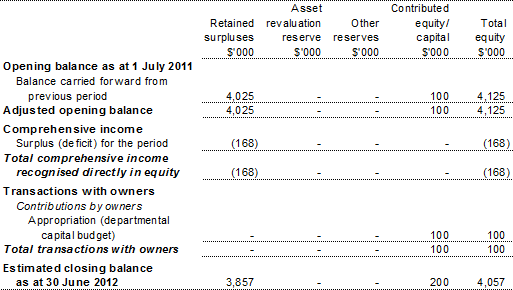
Prepared on Australian Accounting Standards basis.
Table 3.2.5: Departmental capital budget (DCB) statement
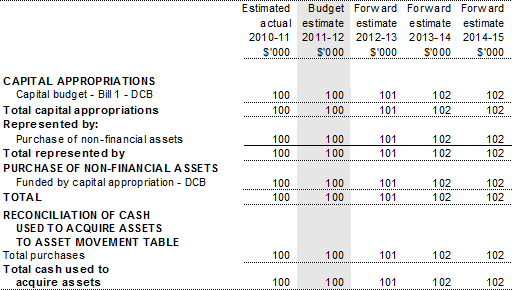
Prepared on Australian Accounting Standards basis.
Table 3.2.6: Statement of asset movements — departmental
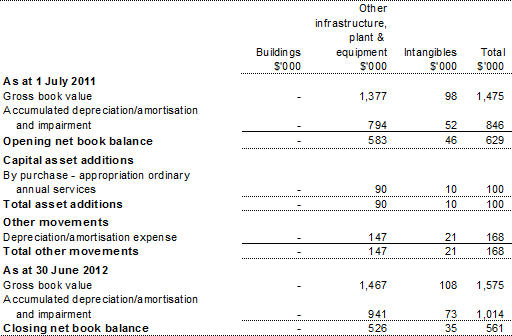
Prepared on Australian Accounting Standards basis.
3.2.4 Notes to the financial statements
The budgeted financial statements have been prepared on an Australian Accounting Standards basis.